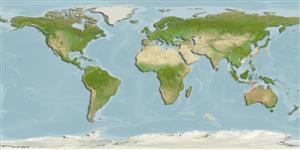>
Ophidiiformes (Cusk eels) >
Carapidae (Pearlfishes) > Pyramodontinae
Etymology: Pyramodon: Greek, pyramis = pyramid + Greek, odous = teeth (Ref. 45335).
Environment: milieu / climate zone / depth range / distribution range
Ecologia
marinhas batidemersal; intervalo de profundidade 250 - 385 m (Ref. 34024). Deep-water
Western Pacific: Japan to northern Australia.
Tamanho / Peso / Idade
Maturity: Lm ? range ? - ? cm
Max length : 36.0 cm TL macho/indeterminado; (Ref. 6347)
Eel-like, moderate to relatively deep body depth; a large single vomerine fang; pelvic fin rays present; swim bladder large, filling visceral cavity and extending past anus; dorsal and anal fin radials robust and elongate; dorsal fin anteriad or directly over anal fin origin; lacking rockerbone, cardiform teeth, and intrinsic swim bladder constrictions or tunic ridges (Ref. 34024). Margins of dorsal and anal fins edged in black over entire length; head and body generally unpigmented (Ref. 34024).
Uncommon species (Ref. 34024).
Life cycle and mating behavior
Maturities | Reprodução | Spawnings | Egg(s) | Fecundities | Larvas
Nielsen, J.G., D.M. Cohen, D.F. Markle and C.R. Robins, 1999. Ophidiiform fishes of the world (Order Ophidiiformes). An annotated and illustrated catalogue of pearlfishes, cusk-eels, brotulas and other ophidiiform fishes known to date. FAO Fish. Synop. 125(18):178p. Rome: FAO. (Ref. 34024)
Categoria na Lista Vermelha da IUCN (Ref. 130435)
Ameaça para o homem
Harmless
Utilização humana
Pescarias: sem interesse
Ferramentas
Relatórios especiais
Descarregue XML
Fontes da internet
Estimates based on models
Preferred temperature (Ref.
123201): 10.9 - 12.9, mean 11.7 °C (based on 12 cells).
Phylogenetic diversity index (Ref.
82804): PD
50 = 0.5625 [Uniqueness, from 0.5 = low to 2.0 = high].
Bayesian length-weight: a=0.00102 (0.00046 - 0.00225), b=3.06 (2.88 - 3.24), in cm total length, based on all LWR estimates for this body shape (Ref.
93245).
Nível Trófico (Ref.
69278): 3.8 ±0.5 se; based on size and trophs of closest relatives
Fishing Vulnerability (Ref.
59153): Low to moderate vulnerability (26 of 100).
